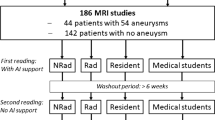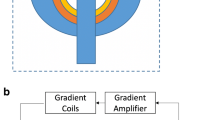Abstract
Purpose
Purpose of our research was the evaluation of a dedicated dental surface coil in comparison with a standard head and neck coil for the improvement of dental magnetic resonance imaging (MRI).
Materials and Methods
Axial T1-weighted spin echo MRI was performed by using a newly developed dental coil for MRI and a standard head and neck coil on five volunteers. In addition, MRI was implemented with dental coil on five patients. Using the Wilcoxon test, we compared the volunteers’ signal-to-noise ratio (SNR) of a variety of anatomical structures (e.g., hard tooth tissue, pulp tissue, bone, muscle tissue). Also subjective evaluation of image quality was performed on both volunteers and patients.
Results
Compared with the head and neck coil, the mean SNR was 3.5-fold higher on an average with the dental coil (range: from 2.7 [masseter muscle] to 4.6 [pulp tissue]). That difference was statistically significant for all evaluated structures. The higher SNR also resulted in a superior image quality as determined by subjective evaluation.
Conclusion
Dental MRI benefits profoundly from using a dedicated dental coil.





Similar content being viewed by others
References
Patel S, Dawood A, Whaites E, Pitt Ford T. New dimensions in endodontic imaging: part 1. Conventional and alternative radiographic systems. Int Endod J. 2009;42(6):447–62.
Nitsche T, Menzebach M, Wiltfang J. S-2-k-Leitlinie: Indikationen zur implantologischen 3D—Röntgen-Diagnostik und navigationsgestützten Implantologie. http://www.dgzmk.de/zahnaerzte/wissenschaft-forschung/leitlinien/details/document/indikationen-zur-implantologischen-3d-roentgendiagnostik-und-navigationsgestuetzten-implantologie.html: Deutsche Gesellschaft für Zahn, Mund- und Kieferheilkunde; 2012.
Energy D-G, DH-NSaS T. Radiation Protection 136, European guidelines on radiation protection in dental radiology, The safe use of radiographs in dental practice. In: Protection UH-R, editor. http://ec.europa.eu/energy/sites/ener/files/documents/136.pdf; 2004.
Claus EB, Calvocoressi L, Bondy ML, Schildkraut JM, Wiemels JL, Wrensch M. Dental X-rays and risk of meningioma. Cancer. 2012;118(18):4530–7.
Scheinfeld MH, Shifteh K, Avery LL, Dym H, Dym RJ. Teeth: what radiologists should know. Radiographics. 2012;32(7):1927–44.
Assaf AT, Zrnc TA, Remus CC, Schonfeld M, Habermann CR, Riecke B, Friedrich RE, Fiehler J, Heiland M, Sedlacik J. Evaluation of four different optimized magnetic-resonance-imaging sequences for visualization of dental and maxillo-mandibular structures at 3 T. J Craniomaxillofac Surg. 2014;42(7):1356–63.
Assaf AT, Zrnc TA, Remus CC, Khokale A, Habermann CR, Schulze D, Fiehler J, Heiland M, Sedlacik J, Friedrich RE. Early detection of pulp necrosis and dental vitality after traumatic dental injuries in children and adolescents by 3-Tesla magnetic resonance imaging. J Craniomaxillofac Surg. 2015;43(7):1088–93.
Gaudino C, Cosgarea R, Heiland S, Csernus R, Beomonte Zobel B, Pham M, Kim TS, Bendszus M, Rohde S. MR-Imaging of teeth and periodontal apparatus: an experimental study comparing high-resolution MRI with MDCT and CBCT. Eur Radiol. 2011;21(12):2575–83.
Hövener JB, Zwick S, Leupold J, Eisenbeiβ A-K, Scheifele C, Schellenberger F, Hennig J, Elverfeldt DV, Ludwig U. Dental MRI: Imaging of soft and solid components without ionizing radiation. J Magn Reson Imaging. 2012;36(4):841–6.
Idiyatullin D, Corum C, Moeller S, Prasad HS, Garwood M, Nixdorf DR. Dental magnetic resonance imaging: Making the invisible visible. J Endod. 2011;37(6):745–52.
Kress B, Buhl Y, Anders L, Stippich C, Palm F, Bähren W, Sartor K. Quantitative analysis of MRI signal intensity as a tool for evaluating tooth pulp vitality. Dentomaxillofac Radiol. 2004;33(4):241–4.
Ploder O, Partik B, Rand T, Fock N, Voracek M, Undt G, Baumann A. Reperfusion of autotransplanted teeth–comparison of clinical measurements by means of dental magnetic resonance imaging. Oral Surg Oral Med Oral Pathol Oral Radiol Endod. 2001;92(3):335–40.
Kress B, Buhl Y, Hähnel S, Eggers G, Sartor K, Schmitter M. Age- and tooth-related pulp cavity signal intensity changes in healthy teeth: a comparative magnetic resonance imaging analysis. Oral Surg Oral Med Oral Pathol Oral Radiol Endod. 2007;103(1):134–7.
Kaufman L, Kramer DM, Crooks LE, Ortendahl DA. Measuring signal-to-noise ratios in MR imaging. Radiology. 1989;173(1):265–7.
Dietrich O, Raya JG, Reeder SB, Reiser MF, Schoenberg SO. Measurement of signal-to-noise ratios in MR images: Influence of multichannel coils, parallel imaging, and reconstruction filters. J Magn Reson Imaging. 2007;26(2):375–85.
Hargreaves K, Law A. Regenerative endodontics. Cohen’s pathway of the Pulp. St Louis: Mosby Elsevier; 2010. p. 602–919.
Mao JJ, Kim SG, Zhou J, Ye L, Cho S, Suzuki T, Fu SY, Yang R, Zhou X. Regenerative endodontics: barriers and strategies for clinical translation. Dent Clin North Am. 2012;56(3):639–49.
Author information
Authors and Affiliations
Corresponding author
Ethics declarations
Conflict of Interest
The authors declare that there are no actual or potential conflicts of interest in relation to this article.
Rights and permissions
About this article
Cite this article
Gradl, J., Höreth, M., Pfefferle, T. et al. Application of a Dedicated Surface Coil in Dental MRI Provides Superior Image Quality in Comparison with a Standard Coil. Clin Neuroradiol 27, 371–378 (2017). https://doi.org/10.1007/s00062-016-0500-9
Received:
Accepted:
Published:
Issue Date:
DOI: https://doi.org/10.1007/s00062-016-0500-9




